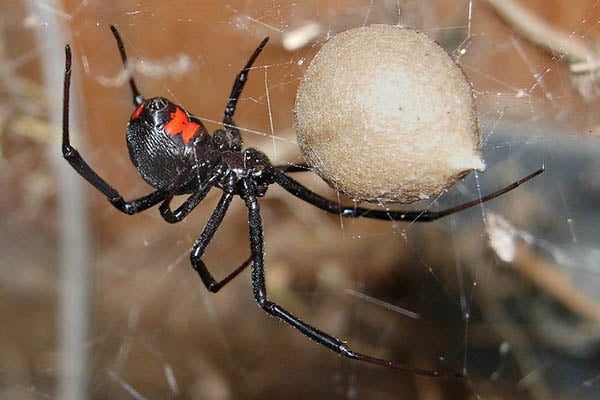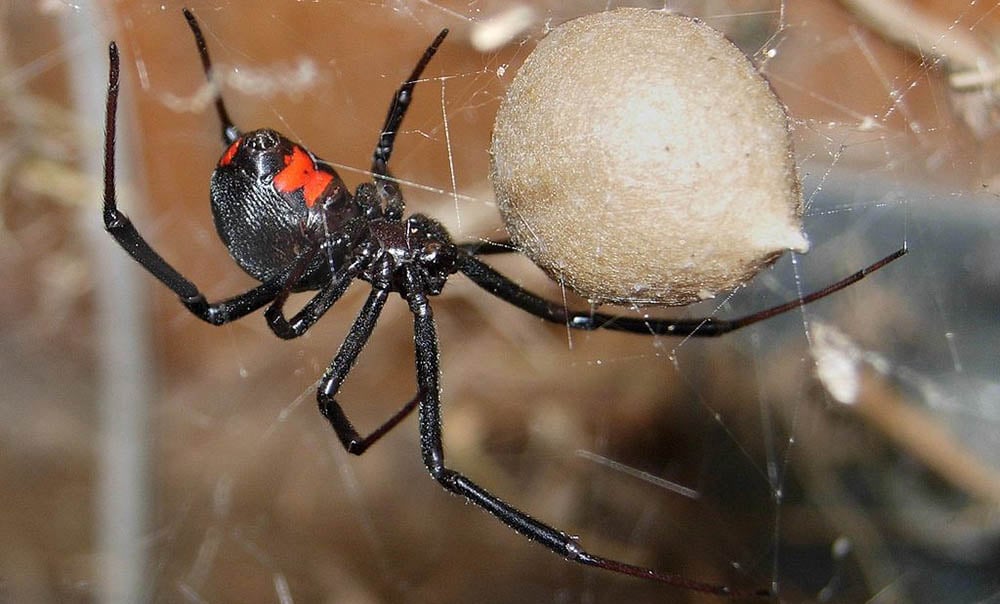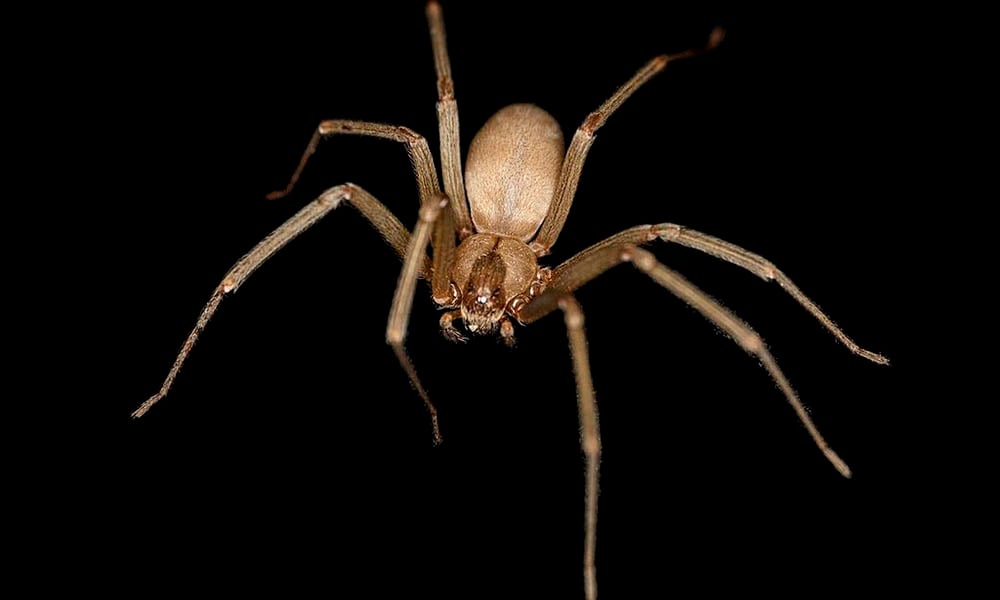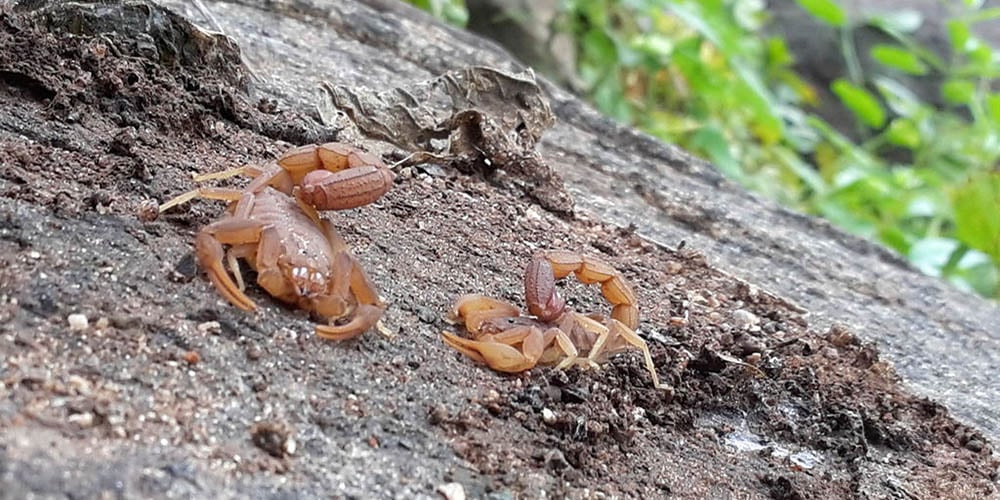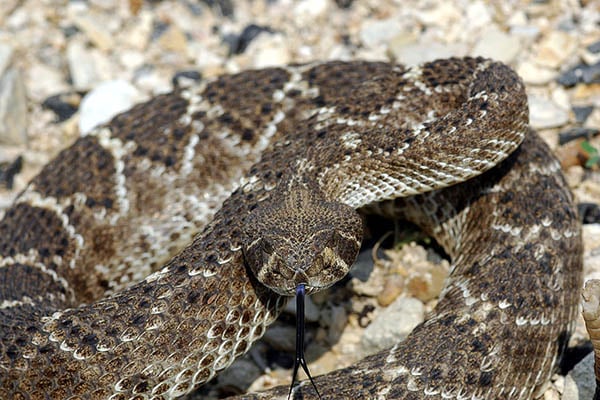Last Updated on
We wrap up our series on animal encounters with smaller venomous creatures that can sneak by you unnoticed but are nonetheless dangerous: spiders and scorpions.
In case you haven’t already, click back to our earlier articles on Bears and Mountain Lions, Other Large Animals and Snakes.
Black Widow Spider
The most infamous venomous spider in the US is the black widow. Females are the only dangerous member of the species as the males pose no threat to humans. They are called the black widow because the females often eat the males after mating. Female black widow spiders are easily identified by red hourglass markings on the underside of the body. Black widows spin a somewhat unorganized, “ratty” and thick web with a lot of debris in it, and this can sometimes be an indication that a black widow is near. They hang at the top of their web, usually with the hourglass sign visible, and descend upon their prey when it gets caught in the web.
Black widows prefer dark, dry places, which makes those crawlspaces, basements and other areas much more frightening for those who are afraid of spiders. They can also be found in dense vegetation and under fallen branches and logs. Avoidance is really the key to minimizing a black widow encounter, and you’ll want to be cautious moving through areas where black widows might frequent. Black widows won’t attack humans unless they are interfered with or accidentally squished, and often they may still try to run versus bite in most situations. Even when black widows bite, they don’t always inject venom because it is a precious resource used mostly for hunting prey. This is not to say their bite shouldn’t be feared, as it is one of the most painful spider bites one can suffer.
When bitten, the first few minutes afterward can be misleading for a victim. The bite only feels like a pin-prick, and then symptoms begin to worsen. Here’s what to do if you’re bitten by a black widow female:
- If bitten by any spider you suspect to be venomous, the best thing you can do is kill it and bag it so a medical expert can identify it. We generally don’t advocate killing wildlife, but species like black widows are far from being endangered, and it will make a difference when it comes to your diagnosis.
- Quickly wash the area to reduce the likeliness of infection, and keep it elevated if possible. Medical experts recommend using pressure from a tourniquet if possible to reduce blood flow to the area. Obviously the tourniquet should still allow some blood to flow so you don’t cut off circulation to your limbs.
- As the minutes pass, you’ll begin to feel pain in all areas of your body, especially the back and lower abdomen, and nausea and difficulty breathing are common. At this point, or earlier if you’re sure you were bitten by a black widow, you should seek medical attention. An anti-venom, pain killers and other medicine will be needed to relieve the symptoms and help you through the bite.
- Black widow bites are rarely fatal, but they are painful. If you have children, you’ll want to be extra cautious if they are in an area where black widows may be found.
Gear Recommendations
There isn’t anything you can carry to help with black widow bites in the wild, and medicine like anti-venom is carefully controlled and only available in a medical setting. Wearing thick gloves and a stout, long sleeve shirt while working in a black widow infested area will certainly help, although there is no guarantee there either.
What you can do is change your behavior when you feel something crawling on you, and this works for all insects not just spiders. Most of us react almost instinctively and swat at something that is crawling at us, even before we look at it. This can invite a unwanted sting as you pin the insect to your body and give it little choice but to sting or bite to get out of the situation. Instead of swatting, try brushing at anything that may be crawling on you. Many times you might just sweep that dangerous insect away, and avoid a painful bite in the process.
Brown Recluse
The other “scary” venomous spider most think of in the US is the brown recluse. It is most easily identified by the fiddle or violin shaped marking on its body, but some recluse spiders have a more-pronounced violin while others don’t. It also has only six eyes while most other spiders have eight. The brown recluse is not common in all areas of the US, and it is generally only found in the Midwest and Southern areas of the country, but that’s no guarantee that there isn’t one around you as they can easily make their way to other areas of the US. These spiders, like the black widow, prefer to avoid humans, and they live in dark areas and typically only move during the night. However, recluses often bump up against human habitats, and they have a particular affinity for hitching a ride in cardboard boxes or making nests in debris around houses. Although they would rather avoid humans, they can become aggressive if accidentally disrupted. Even so, recluse bites are rarely fatal.
Surprisingly, most people who are bitten by brown recluses probably won’t even realize it. A small red bump appears on their skin and after several days it usually heals. But a few unlucky victims will experience a much more severe reaction to the bite that can morph into a large, painful lesion that takes many months to heal. You may also have symptoms of nausea or a fever. Medical attention should be sought regardless if you can confirm you’ve been bitten by a recluse. Some other care steps include:
- Wash the area to prevent infection, and ice should be applied to reduce the swelling.
- Kill and store the spider in a bag if possible so your health provider can identify it properly.
- If you can see a violin pattern or six eyes on the spider, it’s best to get medical attention just in case. There is no anti-venom for a recluse bite, and the more-severe bites need time to heal on their own, but you’ll still want to get it checked out regardless.
Arizona Bark Scorpion
Scorpions look intimidating and we’ve been taught to be weary of their sting, but in reality almost all scorpions in the US are relatively harmless. Still, all scorpions are venomous in some regard, and their sting can still be painful so any close encounter should be avoided. The one exception to this is the dangerous Arizona Bark Scorpion, and a sting from one has the potential to be life threatening. Bark scorpions are only found in the Southwest part of the country in areas like Southern California and Arizona. They are small and easily missed, and they are good climbers so they can be found anywhere from trees and rock faces to people’s homes.
Unfortunately, bark scorpions can be hard to identify for the layman. They do glow under a UV light, but for those that don’t have one, most bark scorpions have a lighter tan color with a slightly darker tan color on the stinger portion of the body. Even with those characteristics in mind, it’s hard to identify them, and anything that remotely resembles the scorpion, especially if it is climbing, should be avoided. They will sting if stepped upon or if they feel threatened, and they pose a significant threat to the young and the old. People can also be allergic to the bark scorpion sting, which makes the reaction much more severe. Aside from significant pain, trouble breathing, nausea, excessive sweating, and foaming at the mouth can occur after a sting. If you believe you’ve been stung by a bark scorpion, follow these steps:
- Capture the scorpion after a sting if possible so a medical professional can inspect it.
- Call or leave for immediate medical treatment as an anti-venom will need to be administered in many circumstances. Other care may be needed for any experiencing significant symptoms from a sting. Bark scorpion stings are rarely fatal, but they should be taken very seriously.
Images one and thumb, two and three courtesy of Wikimedia Commons.
